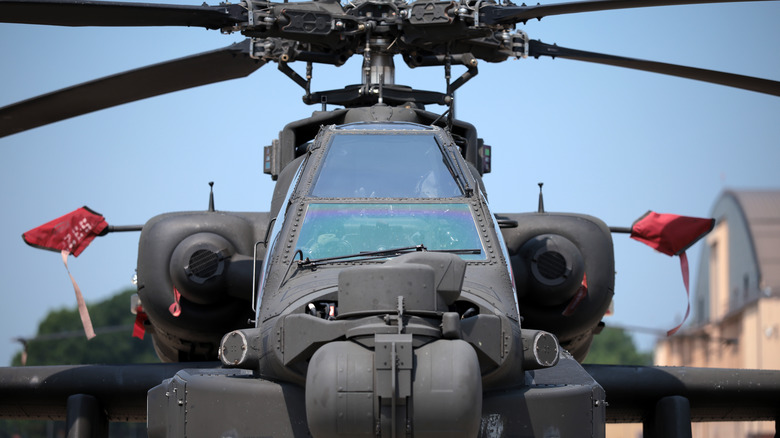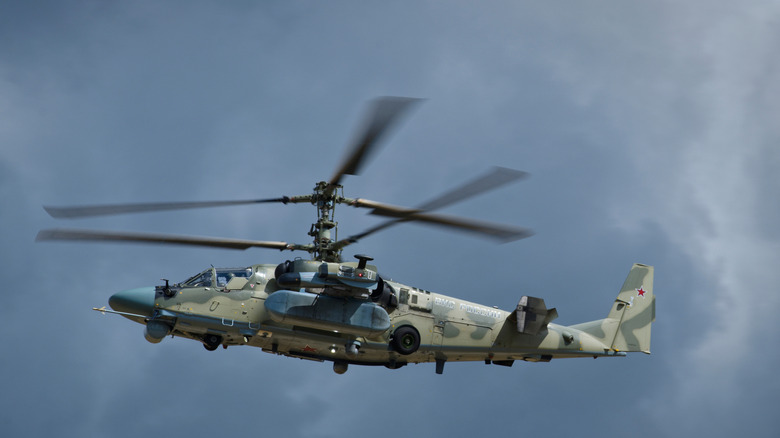How The War In Ukraine Revealed The Attack Helicopter's Vulnerability In Modern Warfare
The famed AH-64E Apache, prominent in the U.S. fleet, is a force to be reckoned with. The U.K. Ministry of Defense deems it "the most advanced Attack Helicopter in the world," but like its rotor-whiring kin, it has a challenging future ahead in a battlefield dominated by drones. As though to emphasize this, a deal for 36 Apaches, worth approximately $2.2 billion, was canceled by South Korea in July 2025. Explaining the decision, South Korea made plain that it had doubts about the future of attack helicopters. "Rather than clinging to expensive legacy platforms, we must invest in capabilities that reflect the future of warfare," People Power Party representative Yu Yong-weon told The Korea Times. The priority would instead be "to invest in drones and other cutting-edge systems."
In the realm of attack helicopters, the Apache is certainly a cutting-edge system. At a price of approximately $52 million each, though, it's an increasingly difficult one to justify. A loss of a single Apache can be a calamity, while many low-cost drones can overwhelm opposing anti-air defenses through sheer numbers.
The war in Ukraine has been marked by such heavy use of drones, and so creative means to destroy them have been sought. In May 2025, BBC News reporter Yogita Limaye spoke with some members of the Ukrainian 68th Jaeger Brigade in Rodynkse. In response to the rise in usage of the deadly fiber optic drones, which are connected to their operator physically and cannot be jammed in the same fashion as their more conventional counterparts, one of them quipped, "maybe we should carry scissors to cut the cord." The proliferation of drones and of the corresponding air defenses intended to tackle them, means that the skies have perhaps never been so dangerous for attack helicopters.
What drones can do that attack helicopters cannot
In July 2025, CNN reported that "Hundreds of Russian drones" attacked the Ukrainian capital, and that they were "flying at different altitudes, and attacking from all directions." Of course, a relatively cheap drone isn't nearly as sophisticated an aerial weapon as a brand-new Apache helicopter. To simply compare the two like-for-like, however, is to miss the point. Drones can be, and have been, utilized on an enormous scale in the war in Ukraine. They can be acquired on a scale that the military helicopter absolutely cannot, for obvious reasons. Russia and Iran both utilize the Shahed family of drones, a relatively cheap and powerful package that can be dispatched in great numbers.
In July 2025, the Atlantic Council reported that "at present, Russia is able to launch more than 500 drones at Ukraine in a single night." To enable such attacks, Russia is able to make use of its own factories, which the outlet reports can make as many as 60,000 drones over the course of a year. Such production numbers allow for relentless, constant barrages in huge waves. Meanwhile, features such as heavier payloads and improved functionality help make them both more likely to reach their target and capable of unleashing more damage when they do. Attack helicopters simply can't be acquired in such numbers, whether exported from other nations or developed at home. These strategies being employed during the war in Ukraine, in short, wouldn't be possible with helicopters instead.
The attack helicopter's place in modern warfare remains a question mark
None of this is to deny, of course, that the attack helicopter is a formidable asset. The Ka-52 Alligator, in particular, has been utilized by Russia during the war, and with the option of equipping IGLA-V missiles, it can bring its firepower to bear against opposing aircraft if need be. Its specialism, however, is in attacking positions on the ground, including valuable armored assets. VIKHR missiles were an effective means of doing just that.
As the conflict wears on, the Ka-52 has been enhanced, with the LMUR missile allowing it to strike crucial armor from a longer distance. This is very important because helicopters are often more vulnerable up close. Army Technology reveals that of the Russian helicopters destroyed in Ukraine during year one of the conflict, two-thirds were destroyed by fire from small arms (17 percent) and MANPADS – Man-Portable Air Defense Systems – (49 percent) combined.
With attack helicopters, then, there can be a severe imbalance between the expensive of developing or purchasing and supplying the aircraft, versus the relatively cheap means that can be effective in destroying them. MANPADS, such as the iconic Stinger, can be quickly fired from the ground to lock onto their target via infrared. They're easy to use, versatile, and, perhaps most dangerously of all, are super difficult for a helicopter to anticipate. Such a defensive solution would be very difficult to utilize against numerous targets, like a swarm of drones, but attack helicopters are enormous priority targets (literally and figuratively) in comparison. Even the most feared attack helicopter is much more vulnerable at times than you might think. The most significant plus of unpiloted aircraft that is that they don't put their pilots in harm's way.


